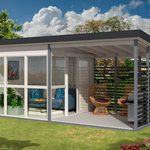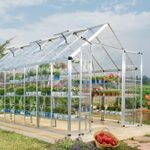Top 5 Types of Wood to Use When Building a Shed
For many, a backyard shed is a dream project. If you're one of those people, these are the types of wood to consider when it's time to buy materials.
Our editors and experts handpick every product we feature. We may earn a commission from your purchases.
Got plans to add a backyard shed to your property? The wood you choose for this project can have a big influence on how your new shed looks, how it performs and how long it lasts. Learn about the five best types of wood for shed building right here and you’ll enjoy a better place to store yard tools, the lawn mower and all those outdoor toys.
Framing Lumber
Every wooden shed has some kind of underlying wall and roof frame built with framing lumber. Also called “construction-grade lumber,” this wood is usually 1-1/2 in. thick solid fir or spruce. The good old 2×4 (actual measurement 1-1/2 in. x 3-1/2 in.) is the most common kind of framing lumber used to build sheds. Given the size of most backyard sheds, 2x4s can usually be used for both the wall and roof frames.
Pressure-Treated Lumber
This wood is just like regular framing lumber, except it has been factory-treated to reduce or prevent rot. Any time wood is used in applications that put it within a few inches of soil, it should be pressure-treated lumber. Even within the category of pressure-treated lumber, there are different kinds. The most common is mildly treated against rot. Although it will remain sound indefinitely if kept away from soil contact, it will rot under continually moist conditions. The most durable form of pressure-treated lumber is made for below-ground foundations. This wood has been treated enough that it won’t rot, not even when in contact with damp soil for decades. This type of pressure-treated lumber is sold for use building pressure-treated wood foundations (abbreviated PWF) and is the ideal choice for any part of your shed that touches the ground.
Oriented Strand Board (OSB)
Every shed has two main parts: a structural frame and sheathing that covers the frame. Oriented strand board (OSB) is the least expensive option for sheathing the walls and roof of a shed, which is why it’s used so often for sheds and homes.
OSB is made of chips of softwood glued together in a semi-random pattern. As with plywood, OSB typically comes in 4 ft. x 8 ft. sheets. And while seven-sixteenth in. thick OSB does a fine job sheathing the walls and roof of a shed, it is a bottom-of-the-barrel sheet material for several reasons. It’s not as strong as plywood, it doesn’t age well when exposed to weather, and the off-cuts aren’t as useful as plywood for building other projects because the edges don’t accept screws or nails well. For a shed, OSB sheathing will work, but not as well as plywood.
Exterior-Grade Plywood
This type of wood is like OSB but stronger and more weather resistant. Plywood is made from thin slices of wood glued together in layers. Plywood off-cuts can be used to make boxes, utility shelves and other small woodworking projects after your shed is done.
You’ll find one-half in. thick plywood works well for wall and roof sheathing, but use at least five-eighths in. plywood for your shed floor. Ordinary exterior-grade plywood is made with weather-resistant glue, but the wood itself is not particularly rot resistant. This is why pressure-treated plywood is best for a shed floor. Even a floor that’s raised off the ground a bit will last longer if it’s made with pressure-treated plywood.
Sheet Wall Siding Panels
Let’s say you’ve got the frame of your shed up and you want to sheath the walls with panels that look good and are able to stand up to the weather. Different types of softwood plywood-type sheet material are made for this job, including the ever-popular T1-11 plywood siding panel. Home improvement stores carry a range of these decorative exterior wall siding sheet materials. All are designed to function as weatherproof wall sheathing applied directly against the wall frame of a shed.



